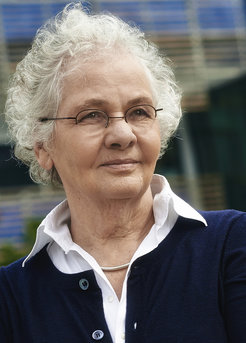„Something of a miracle“
Nobel laureate Christiane Nüsslein-Volhard celebrates her 80th birthday
Christiane Nüsslein-Volhard set milestones in developmental biology and fundamentally shaped today's understanding of embryonic development. She was the first German woman to be awarded the Nobel Prize in Physiology or Medicine, in recognition of her identification of developmental genes in the fruit fly. But also vertebrates such as zebra fish served her as model organisms for her pioneering work. Today, on her 80th birthday, Christiane Nüsslein-Volhard can look back on a lifelong passion for biology and an enduring bond with her chosen home Tübingen.

“We wanted to know how life works.” With these words, Christiane Nüsslein-Volhard describes what drove the research that won her the Nobel Prize in Physiology or Medicine in 1995, together with Eric Wieschaus and Edward Lewis.
This enthusiasm for everything that lives had gripped her from an early age: as a child, she collected and identified plants, had snails race against each other, and eagerly devoured the biology books her parents gifted her. When Christiane Nüsslein-Volhard thinks back to those days, she likes to describe herself as a rebellious student: she used to get into trouble in school because she only put in effort if she was really interested in the subject. And the subject that fascinated her the most was always biology.
Hence, it can hardly surprise that after finishing high school she turned to the sciences, especially life sciences. Shortly after the University of Tübingen established the nationwide first study program in biochemistry, she moved from her hometown Frankfurt to the Swabian university town, where once DNA had been discovered.
A cornerstone of today's understanding of embryonic development
Several years and scientific waystations later, while working as a group leader at the European Molecular Biology Laboratory (EMBL) in Heidelberg, Nüsslein-Volhard was finally able to formulate some answers to her question how life works. Or, more precisely, to the mystery of how a complex organism can form from a seemingly structureless egg. "This is, after all, something of a miracle," she muses. Together with her colleague Eric Wieschaus, she laid the foundations for our current understanding of the genetic mechanisms that determine early embryonic development. The two researchers succeeded in identifying genes that control early development in the fruit fly Drosophila melanogaster. Some of the genes determine, for example, which cells make up the fly's back and abdomen, while others control the division of an embryo into different body segments and their development.
Interestingly, the team’s approach of using genetics to solve developmental biology questions was not immediately met with undivided enthusiasm from their peers: "We were real pioneers, and that was evident from the fact that many people didn't understand our work." Nevertheless, the groundbreaking work encouraged a number of other researchers to pursue further studies: research quickly showed that the same or similar genes as in the fruit fly also influence the development of vertebrates. This paved the way for medical applications of Nüsslein-Volhard's basic research: today, it has long been recognized that her findings have far-reaching consequences for modern cancer therapy as well as congenital malformations and spontaneous abortions.
Return to the cradle of biochemistry
Nüsslein-Volhard maintained a lifelong connection with Tübingen, the historic cradle of biochemistry that had been her place of study. In 1981, she returned there as a research group leader at the Friedrich Miescher Laboratory. "What made this novel and special was our independence”, she recalls. “We had a great deal of freedom and no real bosses."
As a matter of fact, it was her work in Tübingen at the Friedrich Miescher Laboratory (and after 1985 as a director at the Max Planck Institute for Developmental Biology, now the Max Planck Institute for Biology Tübingen) that brought her sudden fame in the 1980s – long before her earlier Heidelberg oeuvre was awarded the Nobel Prize. During those early Tübingen years, Nüsslein-Volhard revolutionized developmental biology with the discovery of morphogens: signaling molecules whose non-uniform distribution controls the development of living organisms.
“Veneration – how horrific!“
When Stockholm called in 1995, Christiane Nüsslein-Volhard was already a world-renowned scientist. Despite her euphoria, she had (and still has) an ambivalent relationship to this honor. Too well did she remember the awe which Nobel Prize winners used to inspire in her: "If people now started to freeze in veneration for me – that would be horrific!”, she feared.
Since the early 1990s, her research group has been focusing on the development and genetics of the zebra fish Danio rerio. Currently, her team is primarily researching the genetic basis of pattern formation in these fish and some closely related species. Such topics – patterns, colors, and beauty of animals – also help her spread her enthusiasm for all living beings and their evolution to a broad public. With the fish laboratory, Nüsslein-Volhard has contributed significantly to establishing zebra fish as model organisms and to defining international standards for keeping them in the lab.
In the future, Nüsslein-Volhard will be able to devote more time to her other passions: singing, cooking, her garden. Her hospitality and her fondness for convivial evenings – famous because she used to enjoy hosting her many colleagues – are likely to remain unchanged.
Nüsslein-Volhard no longer wants to actively head a research group. But it is certain that after her 80th birthday she will find new ways to exercise her energy and creativity: "I'm curious to see what happens then. After all, I've already written a few books; maybe I'll have to write another one."
